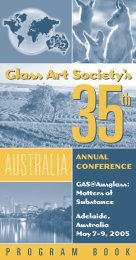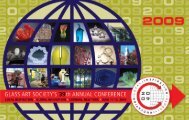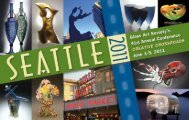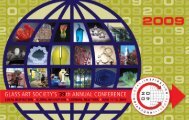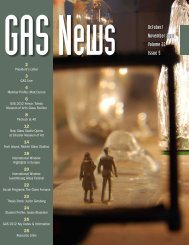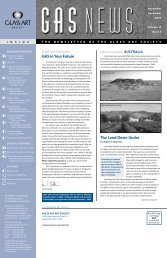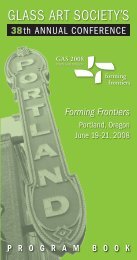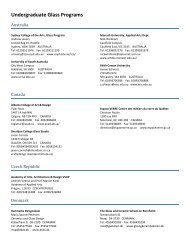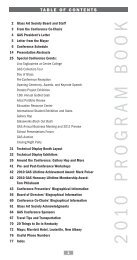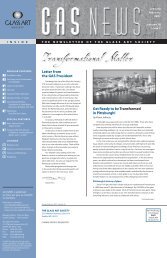Herding Individualists NOW MAKING GAFFER ... - Glass Art Society
Herding Individualists NOW MAKING GAFFER ... - Glass Art Society
Herding Individualists NOW MAKING GAFFER ... - Glass Art Society
Create successful ePaper yourself
Turn your PDF publications into a flip-book with our unique Google optimized e-Paper software.
esources, etc.<br />
technical article<br />
12<br />
PLEASE NOTE: Publication of notices is for information<br />
purposes only and does not necessarily indicate endorsement<br />
by the <strong>Glass</strong> <strong>Art</strong> <strong>Society</strong>.<br />
We are happy to include information as supplied to us by<br />
various sources. Please send us your press releases and notices<br />
including specific, current facts as far in advance as possible to:<br />
GAS, 3131 Western Avenue, # 414, Seattle, WA 98121 or e-mail<br />
to: Shannon@glassart.org. GAS NEWS is a bi-monthly publication.<br />
Members receive their newsletters approximately 6-8 weeks<br />
after the deadline.<br />
Upcoming Newsletter Deadlines:<br />
December 15 for the March 2006 issue<br />
February 1 for the April/May 2006 issue<br />
We look forward to hearing from you.<br />
Calls to <strong>Art</strong>ists<br />
COMPETITIONS<br />
4th Annual Ugly Necklace Contest 2006, A Jewelry Design<br />
Competition With A Twist. Yes, an UGLY Necklace Contest.<br />
Can you put together a well-designed and functional, yet UGLY,<br />
necklace? The Fourth Annual Ugly Necklace Contest for 2006<br />
is offering a first prize of a $992.93 shopping spree on the Land<br />
of Odds website (www.landofodds.com), and a Runner-Up prize<br />
of a $399.07 shopping spree on the website. To enter, take<br />
three good color snapshots or scans of your necklace, and<br />
write a short poem about it, and submit by March 15, 2006.<br />
Entries will be judged by a panel from The Center for Beadwork<br />
& Jewelry <strong>Art</strong>s. These distinguished Beadwork and Jewelry<br />
<strong>Art</strong>ist instructors will judge based on the hideousness of the<br />
necklace, its shape, color and use of materials, its functionality<br />
and wearability, how well the artist has shown an understanding<br />
of good design principles (and how to violate them).<br />
For more information contact: Land of Odds, 522 E Iris Dr,<br />
Nashville, TN, 37204. Tel: 615-292-0610, Fax: 615-460-7001,<br />
warren@landofodds.com, www.landofodds.com.<br />
Best of <strong>Art</strong>ists America Book Series Kennedy Promotions<br />
is producing its second unique new book series, The BEST OF<br />
AMERICA: GLASS ARTISTS 2005, 200+ winners featured in a<br />
beautiful soft cover book listed with major online booksellers.<br />
Cash prizes awarded to five best in show. Open to all U.S. glass<br />
artists. Also included is a special Emerging artist category.<br />
$30/3 slides, 4 x 6 photos, or CD entries, $5 for each additional<br />
entry. Deadline: February 15, 2006. For more information<br />
contact: Kennedy Promotions Best Of, P. O. Box 6876,<br />
Williamsburg, VA 23188, Tel: 757-564-6261, artbestof@yahoo.com,<br />
www.bestofartists.com.<br />
<strong>Glass</strong> Competition The <strong>Glass</strong> Axis, in Columbus, OH is hosting<br />
a juried glass commission competition. The projects submitted<br />
are for sites in the headquarters of a large telecommunications<br />
company. To download a prospectus and pictures, go to our<br />
website at: www.glassaxis.org/west_proposal/. Deadline for<br />
submission is March 1, 2006. Please call 614-291-4250 or send<br />
an e-mail for further information (studiodirector@glassaxis.org).<br />
For more information contact: <strong>Glass</strong> Axis, 1341 Norton Ave Ste<br />
B, Columbus, OH, 43212, Tel: 614-291-4250, Fax: 614-291-0122,<br />
studiodirector@glassaxis.org, www.glassaxis.org.<br />
EXHIBITIONS<br />
Courthouse Gallery Call to <strong>Art</strong>ists <strong>Art</strong>ists are invited to<br />
submit slides of recent work for the Lake George <strong>Art</strong>s Project’s<br />
Courthouse Gallery 2007 exhibition season. The Courthouse<br />
Gallery presents five to seven exhibitions yearly of regional<br />
and national contemporary visual artists in all media. Strong<br />
preference given to work created within the last two years.<br />
Submission Guidelines: Ten to twelve 35-mm slides of recent<br />
work in a plastic slide sheet (marked with artist’s name, top of<br />
slide, medium, date and dimensions), slide list, resume and<br />
artist’s statement, and self-addressed-stamped-envelope for<br />
slide return. At this time the Gallery Committee cannot accept<br />
CDs, emailed submissions, or links to websites in lieu of slide<br />
submissions. Deadline for submission is January 31, 2006. For<br />
more information contact: Lake George <strong>Art</strong>s Project, 1 Amherst<br />
St, Lake George, NY, 12845, Tel: 518-668-2616, Fax: 518-668-3050,<br />
mail@lakegeorgearts.org, www.lakegeorgearts.org.<br />
Kiln Processes Using Recycled <strong>Glass</strong>: A Juried Competition<br />
and Exhibition for Fine <strong>Art</strong>, Crafts, and Industrial Products<br />
The purpose of this competition is to showcase exemplary<br />
artistic glass, ceramics and industrial products using recycled<br />
glass. Deadline is February 15, 2006. For more information,<br />
a set of guidelines, or an application packet contact: Center<br />
for Environmental Economic Development, PO Box 4167,<br />
Arcata, CA, 95518-4167, Tel: 707-822-8347, Fax: 707-822-4457,<br />
ceed@humboldt1.com, www.ceedweb.org/glass.<br />
North American <strong>Glass</strong> 2006 The Guilford <strong>Art</strong> Center presents<br />
the biennial glass exhibit North American <strong>Glass</strong> 2006. <strong>Art</strong>ists<br />
may submit up to three pieces. Applications are due January<br />
27, 2006. Notifications will be mailed February 21. Exhibit runs<br />
May 14 through June 25, 2006. Cash awards totaling $1,000 will<br />
be awarded. For more information contact: Guilford <strong>Art</strong> Center,<br />
411 Church Street, PO Box 589, Guilford, CT, 06437, Tel: 203-<br />
453-5947, Fax: 203-453-6237, gallery@guilfordartcenter.org,<br />
www.guilfordartcenter.org.<br />
GALLERIES<br />
Luniverre Gallery in Paris seeks emerging and established<br />
artists working in cast glass and/or mixed media for our<br />
biannual group shows, December to February and July to<br />
September. Please send CV and artists statement with 10-20<br />
slides, dimensions, and price of works, together with SASE to:<br />
Glenmagus, 272 Glen Farm Road, Portsmouth, RI 02871.<br />
Luniverre Gallery, 20 rue des Coutures St. Gervais, Paris,<br />
75003, France, Tel: +33-1-4461-0481, Fax: +33-1-4461-7062,<br />
www.luniverre.com.<br />
Good Things | Small Packages: An Intimate Look at Small<br />
<strong>Glass</strong> Public <strong>Glass</strong>, San Francisco’s center for creation and<br />
education in glass, invites all glass artists who work on a small<br />
scale to apply for this juried exhibit and publication which will<br />
feature small sculpture, paperweights, scent bottles and glass<br />
beads. All pieces must be no larger than four inches in any<br />
dimension. Jury fee is $25 for three works. Entries due<br />
January 24, 2006. For more information and to download<br />
an application, please visit www.publicglass.org. or e-mail<br />
janicepeacock@comcast.net with questions.<br />
OTHER<br />
Call for Papers: Space Exploration Within and Beyond the<br />
Image aims to examine ways space is constructed in visual<br />
representation and through social experience from a range<br />
of cultural, historical and methodological perspectives. We<br />
invite graduate students to submit papers addressing issues<br />
of space, specifically ways it has been framed, activated or<br />
otherwise produced in visual culture. Papers might address<br />
such media as sculpture, dioramas, landscape, installation art,<br />
performance, architecture and urban design, film, or tableaux<br />
vivants, etc. Other areas of inquiry might include display,<br />
the plinth, theatricality and absorption, spatial schematics,<br />
interiors, ritual spaces, borders, and virtual space. We welcome<br />
submissions from all areas of art history and related fields.<br />
In addition, we invite submissions from practicing artists and<br />
filmmakers engaged with ideas and problems of space in<br />
their work. Papers should be between 15 and 20 minutes in<br />
length. Abstracts of no more than 500 words, a current CV,<br />
and contact information should be submitted by Monday,<br />
January 16, 2006, via e-mail or post to the address below.<br />
Some travel funding is available. Graduate Symposium<br />
Committee, Department of <strong>Art</strong> History, University of Southern<br />
California, VKC 351- MC 0047, Los Angeles, CA, 90089.<br />
Contact: uscgradsymposium@gmail.com.<br />
Shows + Fairs<br />
10th Annual Craft As <strong>Art</strong> Festival Sept. 29, 30, and Oct. 1 at<br />
the Nassau County Museum of <strong>Art</strong>, Roslyn Harbor, NY. Work<br />
must be original. Applicants must submit five color slides<br />
and an SASE with 65 cents postage. Deadline is Jan. 4, 2006.<br />
After this date, applications will be reviewed periodically<br />
until the show is filled. For more information contact:<br />
American Concern for <strong>Art</strong>istry and Craftsmanship, PO Box 650,<br />
Montclair, NJ, 07042, Tel: 973-746-0091, Fax: 973-509-7739,<br />
www.craftsatlincoln.org.<br />
1st Annual Craft as <strong>Art</strong> Festival Oct. 14, 15 and Oct. 21, 22<br />
at the Brooklyn Museum, Brooklyn, NY. Work must be original.<br />
Applicants must submit 5 color slides and an SASE with 65<br />
cents postage. Deadline is January 4, 2006. After this date,<br />
applications will be reviewed periodically until the show is<br />
filled. For more information contact: American Concern for<br />
<strong>Art</strong>istry and Craftsmanship, PO Box 650, Montclair, NJ, 07042,<br />
Tel: 973-746-0091, Fax: 973-509-7739, www.craftsatlincoln.org.<br />
21st Annual Autumn Crafts Festival Sept. 9-10, 16-17 at<br />
Lincoln Center for the Performing <strong>Art</strong>s, New York, NY. Work<br />
must be original. Applicants must submit 5 color slides<br />
and an SASE with 65 cents postage. Deadline is January 4,<br />
2006. After this date, applications will be reviewed<br />
periodically until the show is filled. <strong>Art</strong>ists may apply for one<br />
or both weekends. For more information contact: American<br />
Concern for <strong>Art</strong>istry and Craftsmanship, PO Box 650,<br />
Montclair, NJ, 07042, Tel: 973-746-0091, Fax: 973-509-7739,<br />
www.craftsatlincoln.org.<br />
30th Annual American Crafts Festival June 3- 4, 10-11 at<br />
Lincoln Center for the Performing <strong>Art</strong>s, New York, NY. Work<br />
must be original. Applicants must submit 5 color slides and<br />
an SASE with 65 cents postage. Deadline is January 4, 2006.<br />
After this date, applications will be reviewed periodically until<br />
the show is filled. <strong>Art</strong>ists may apply for one or both weekends.<br />
For more information contact: American Concern for <strong>Art</strong>istry<br />
and Craftsmanship, PO Box 650, Montclair, NJ, 07042,<br />
Tel: 973-746-0091, Fax: 973-509-7739, www.craftsatlincoln.org.<br />
Sunfest 2006 SunFest of Palm Beach County, Inc. is currently<br />
seeking artists for the 24th annual Fidelity Federal Fine <strong>Art</strong> &<br />
Craft Show, scheduled for May 4 through May 7 of SunFest<br />
2006. SunFest, Florida’s largest music, art and waterfront festival,<br />
takes place along the Intracoastal Waterway in downtown<br />
West Palm Beach. Participants in the show are eligible to win<br />
one of 22 awards totaling $16,000. Approximately 165 artists<br />
will display works in 11 categories including drawing, fiber<br />
textiles, fine art sculpture, glass, jewelry/metal, mixed media<br />
(2D & 3D), painting, photography, pottery/ceramics and wood.<br />
Applications and entry qualifications are available from the<br />
SunFest website. To receive an application by mail send a<br />
self-addressed stamped envelope to Sunfest. Completed<br />
applications must be received no later than February 3, 2006.<br />
For more information contact: SunFest of Palm Beach<br />
County, Inc., 525 Clematis St, West Palm Beach, FL, 33401,<br />
Tel: 561-659-5980, Fax: 561-659-3567, www.sunfest.com.<br />
Coldworking<br />
with Diamond Tools<br />
By Jiyong Lee<br />
Advertise in the<br />
2006 Resource Guide<br />
The annual GAS Resource Guide is a collection of<br />
ads from manufacturers and suppliers of glass-related<br />
goods and services, organizations, publications, schools,<br />
galleries and museums from around the world, and is<br />
used by GAS members as a reference guide year-round.<br />
The 2006 Resource Guide will be distributed to each<br />
conference attendee at the <strong>Glass</strong> <strong>Art</strong> <strong>Society</strong>'s 36th<br />
Annual Conference in St. Louis, Missouri, June 15-17,<br />
2006. Following the conference, the Resource Guide<br />
will be mailed to all GAS members who did not attend<br />
the conference.<br />
That's a total distribution of almost 3,000 GAS<br />
members in over 50 countries!<br />
Don’t miss the opportunity to gain visibility for<br />
your company or program in this useful reference<br />
guide. Reserve your space in the <strong>Glass</strong> <strong>Art</strong> <strong>Society</strong><br />
2006 Resource Guide today! Reservations and payment<br />
are due February 15, 2006. Advertising artwork is due<br />
March 1, 2006.<br />
Also, make sure to reserve your space for<br />
the Technical Display at the GAS Conference by<br />
February 15. See our website at www.glassart.org<br />
for more information.<br />
In the long history of glass making, the use of<br />
diamond as an abrasive medium appears to be a<br />
relatively recent development, before which emery<br />
(natural black corundum) or crushed garnet was used<br />
as abrasive material. Modern diamond tools are high<br />
precision grinding tools made to exacting limits not<br />
only for glassmakers, but also for scientists and engineers<br />
as well. There are two different types of diamond<br />
tools, with the distinction being the way the diamonds<br />
are bonded to the body of the tool. These two bonding<br />
methods are known as “sintering” and “plating.”<br />
Sintered diamond tools have diamond mixed into<br />
the bronze metal (usually mix of copper + tin or nickel)<br />
and bonded by means of heat and pressure. They are<br />
longer lasting than plated tools but are also more<br />
expensive. Using and redressing sintered diamond<br />
tools wears away the bonding material to expose new<br />
diamonds. There are different alloys used as bonding<br />
substrates for use in various applications. For example,<br />
a harder bonding alloy should be chosen for tools<br />
intended to cut harder materials because the harder<br />
the material being cut, the faster it will wear away the<br />
tools’ bonding alloy, thus tending to release diamonds<br />
before they are spent. Conversely, a very hard bonding<br />
alloy is used on a tool to cut a soft material, then the<br />
diamonds tend to become dull and not released easily<br />
enough to expose new sharp diamonds.<br />
Over time, sintered tools’ profiles can change but<br />
can be re-profiled by their manufacturers, who recommend<br />
using these tools in one direction only because<br />
of what is known as “comet tail”. The bronze that does<br />
not get worn away from behind each diamond particle<br />
forms what resembles a comet tail and supports the<br />
diamond, holding it in place as it cuts away material.<br />
Initially, the decision of which direction is forward or<br />
reverse is arbitrary, but the user should remain committed<br />
to that direction for the life of the tool. If the tool is<br />
used in reverse, the diamonds on the surface are easily<br />
be knocked out because the comet tail is in front of<br />
them instead of behind them. With the diamonds<br />
knocked out, the existing bronze comet tail, now facing<br />
the wrong way, must be worn away before new diamonds<br />
will be exposed to continue cutting. Essentially,<br />
the malpractice of using sintered diamond tools in<br />
opposing directions not only wastes the time of not<br />
cutting material at an optimal rate, but it also shortens<br />
the life of the tools dramatically by prematurely<br />
knocking out unspent diamonds.<br />
Plated diamond tools have diamonds electroplated<br />
to a surface using a bonding agent (usually nickel).<br />
Since plated diamond tools have only one layer of diamonds,<br />
they do not last as long. The positive side is<br />
that plated diamond tools are low-cost. As diamonds<br />
wear out or fall out, the cutting and grinding process is<br />
slowed down, much like what happens with sandpaper.<br />
Theoretically, plated tools can be re-electroplated by<br />
the manufacturer, but unless you have a special, custom<br />
designed tool to re-plate, the process is not cost effective.<br />
Plated diamond tools can be used in opposing<br />
directions because the nickel that holds the diamonds<br />
on the surface of plated tools is much more durable<br />
than the bronze in sintered tools and is therefore not<br />
expected to be worn away in normal use to release<br />
spent diamonds.<br />
A Talk with Maestro Davide Salvadore<br />
Written by Beth Lipman from an interview with Davide Salvadore in July 2005<br />
The Venetian Maestro Davide Salvadore never<br />
really studied glass. <strong>Glass</strong> has always been a part<br />
of his family history; his first memories are from<br />
the glass factory where his father and uncle<br />
worked, and from his house where his mother and<br />
grandmother made beads. When his school day<br />
finished at noon he would come home, eat lunch,<br />
and go to the factory. Davide was eight years old<br />
when he was given his first important responsibility:<br />
stoking the furnaces with wood all afternoon<br />
each day. He remembers himself as a “wild child”<br />
someone who was mischievous; this chore kept<br />
him from getting into trouble. At age ten he<br />
started working on the factory floor.<br />
The young Davide knew he wanted to<br />
become a Maestro because he wanted to be like<br />
his godfather, Cesare. His mother’s brother, Cesare<br />
Mantoan, was a Maestro who had a dynamic<br />
personality and dressed impeccably. Despite his<br />
untimely death at an early age he left a deep<br />
impression on Davide. When Davide was a small<br />
child, he was one of 13 family members living<br />
in the house. The Maestro always received special<br />
treatment; his clothes were always laundered with<br />
special care and he was always served first at the<br />
dinner table. His grandmother loved all of her<br />
sons very much but always made sure the Maestro<br />
had everything he needed.<br />
Another event made Davide aware of the<br />
Maestro’s importance. A Maestro known as the<br />
“Beautiful Grape” lived across the street from<br />
Davide. They were friends and used to joke and<br />
play. Once, when he was walking down the street<br />
with his grandmother, Davide greeted the Maestro<br />
with an informal “Ciao Ciao!” His grandmother<br />
squeezed his hand hard and whispered,“That<br />
is not how you salute a Masestro!” When they<br />
arrived home his grandmother told his parents<br />
In modern glass cold-working studios, both types<br />
of tools are commonly used. Many studios have<br />
grinding machines that use interchangeable diamond<br />
discs, fiberglass plated with nickel and diamonds and<br />
adhered to rubberized magnetic backing pads. Most<br />
diamond saw blades are sintered. Core drill bits and<br />
cutting, carving and engraving wheels are commonly<br />
found in either sintered or plated types.<br />
All diamond tools require the use of water.<br />
Insufficient use of water increases the risk of destroying<br />
both your tools and your glass. All scientific optic glass<br />
companies use synthetic or semi-synthetic coolants<br />
diluted in water to help with cleansing and lubricating<br />
the cutting surface, and to extend diamond tool life.<br />
Using coolant presents several issues, such as reusing<br />
the coolant/water mixture, filtering the mixture as it is<br />
re-circulated in use, and recycling or disposing of the<br />
mixture when spent.<br />
Factors such as the amount of water used, type<br />
of glass materials being processed, how the tools<br />
have been maintained and used, etc., will play a role<br />
in the life and performance of your diamond tool.<br />
Reading operators’ manuals, asking questions of<br />
manufacturers and experts, choosing the proper<br />
tools, and good maintenance will extend the life<br />
of the diamond tools and enhance your working<br />
efficiency as well as your safety.<br />
I would like to thank to Rakow Research Library<br />
of Corning Museum of <strong>Glass</strong> and Kurt Merker Kelheim<br />
for providing reference.<br />
Jiyong Lee, Assistant Professor<br />
<strong>Glass</strong> Program, School of <strong>Art</strong> and Design<br />
Southern Illinois University Carbondale<br />
who scolded him and put him to bed without<br />
eating supper.<br />
Once he decided he was going to become a<br />
Maestro he pushed himself to work harder, faster,<br />
and more accurately. At age 17 he was able to<br />
create extremely complex forms with great speed<br />
and difficulty and earned the title of Maestrino<br />
(young master). One of his first jobs was in the<br />
Dabronzo factory. He worked on a team with<br />
approximately 12 glassworkers; Dabronzo typically<br />
had 15 teams working at once. During the 1960s,<br />
Italians from all regions could find work on<br />
Murano but only Muranese could be Maestros.<br />
He never felt very competitive, although the faster<br />
he worked the more money he earned.<br />
A Maestro is judged by the speed and efficiency<br />
with which he works on the production<br />
line. In Murano, Maestrini always earned a certificate<br />
of accomplishment which entitled them the<br />
title Maestro. The process began with an emerging<br />
artist exhibition, Premio Murano, in which maestrini<br />
exhibited works of glass such as a reticello vessel,<br />
or an extremely thin tumbler. The most prominent<br />
Mastroes and owners of the factories judged the<br />
exhibition and decided who was to earn the certificate.<br />
This tradition died shortly after Davide was<br />
awarded his certificate. A version of the Premio<br />
Murano still continues and the most important<br />
Maestro still attend the exhibition to view emerging<br />
talent. He was awarded his certificate 15 years<br />
ago at age 37. Davide marks this moment in his<br />
life as the moment he felt he was a Maestro.<br />
Beth Lipman is an artist living and working in<br />
southern New Jersey. Her work,“Bancketje,” was<br />
recently exhibited at SOFA Chicago and the Fuller<br />
Craft Museum in Brockton, Mass. She is the Studio<br />
Director of Education and <strong>Art</strong>ist Services at<br />
Wheaton Village.<br />
5



